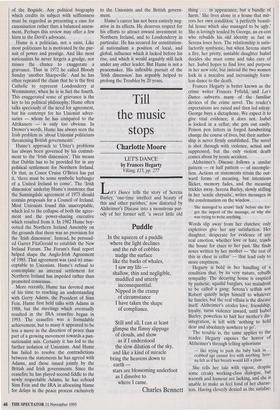Till the music stops
Charlotte Moore
LET'S DANCE by Frances Hegarty Viking £15, pp. 277 Let's Dance tells the story of Serena Burley, 'one-time intellect and beauty of this and other parishes,' now distorted by Alzheimer's Disease into a monstrous par- ody of her former self, 'a sweet little old thing . . . in appearance, but a bundle of harm.' She lives alone in a house that mir- rors her own condition; 'a perfectly beauti- ful house which also managed to be ugly.' She is lovingly tended by George, an ex-con who rebuilds his old identity as fast as Serena loses hers. The relationship is satis- factorily symbiotic, but when Serena starts a fire, her pretty, unstable daughter Isabel decides she must come and take care of her. Isabel hopes to find love and purpose in her new role, but instead the two women lock in a macabre and increasingly form- less dance to the death.
Frances Hegarty is better known as the crime writer Frances Fyfield, and Let's Dance subverts many of the familiar devices of the crime novel. The reader's expectations are raised and then led astray. George buys a dictaphone. We expect it to give vital evidence; it does not. Isabel is locked in a cellar; she gets out easily. Poison pen letters in forged handwriting change the course of lives, but their author- ship is never firmly established. The novel is shot through with violence, actual and suppressed, but the only violent death comes about by ironic accident.
Alzheimer's Disease follows a similar pattern — or half pattern — of incomple- tion. Actions or statements retain the out- ward forms of meaning, but intentions flicker, memory fades, and the meaning trickles away. Serena Burley, slowly stifling in her 'senile chrysalis', writes messages in the condensation on the window.
She managed to scrawl 'luck' before she for- got the import of the message, or why she was trying to write anything.
Words slip away from her clutches; only expletives give her any satisfaction. Her daughter, desperate for evidence of any real emotion, whether love or hate, trawls the house for clues to her past. She finds notes written by her mother — 'the rest of this in chest in cellar' — that lead only to more emptiness.
Hegarty is bold in her handling of a condition that, by its very nature, rebuffs sympathy. The decaying house is emptied by pathetic, squalid burglars, too maladroit to be called a gang; Serena's selfish son Robert quietly helps himself to whatever he fancies, but the real villain is the disease itself. Alzheimer's erodes love, friendship, loyalty, turns violence inward, until Isabel Burley, powerless to halt her mother's dis- integration, is left with 'nothing to hold dear and absolutely nowhere to go'. The trouble is, the same applies to the reader. Hegarty exposes the horror of Alzheimer's through telling aphorisms
— like trying to push the baby back in.. . crabbed age cannot live with anything. Sere- na felt as if her breath would kill a plant.
She tells her tale with vigour, despite some creaky working-class dialogue, but warmth and humour are lacking, and she is unable to make us feel fond of her charac- ters. Having cleverly denied us the satisfac- tions of plot, she aims to replace these with a close psychological involvement with the fates of those concerned. This fails; read- ing Let's Dance is like taking part in a trea- sure hunt in which there are no prizes.



















































































 Previous page
Previous page